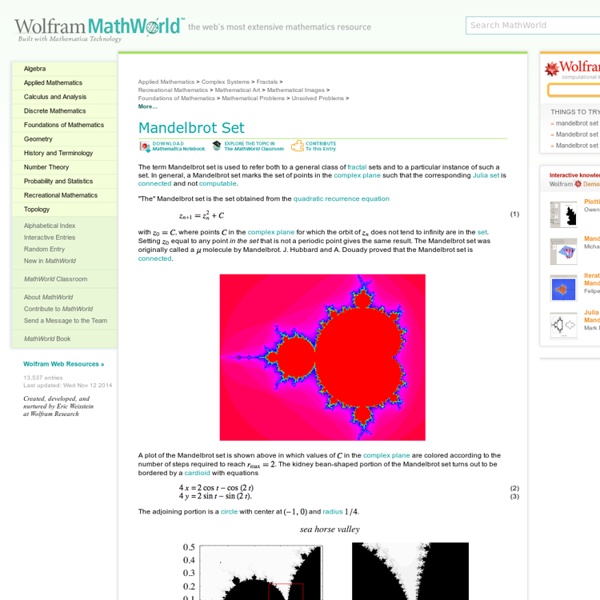Mandelbrot Set

Box-and-Whisker Plots: Interquartile Ranges and Outliers
Box-and-Whisker Plots: Interquartile Ranges and Outliers (page 3 of 3) Sections: Quartiles, boxes, and whiskers, Five-number summary, Interquartile ranges and outliers The "interquartile range", abbreviated "IQR", is just the width of the box in the box-and-whisker plot. That is, IQR = Q3 – Q1. The IQR is the length of the box in your box-and-whisker plot. (Why one and a half times the width of the box? Find the outliers, if any, for the following data set: To find out if there are any outliers, I first have to find the IQR. Outliers will be any points below Q1 – 1.5×IQR = 14.4 – 0.75 = 13.65 or above Q3 + 1.5×IQR = 14.9 + 0.75 = 15.65. Then the outliers are at 10.2, 15.9, and 16.4. The values for Q1 – 1.5×IQR and Q3 + 1.5×IQR are the "fences" that mark off the "reasonable" values from the outlier values. By the way, your book may refer to the value of "1.5×IQR" as being a "step". Find the outliers and extreme values, if any, for the following data set, and draw the box-and-whisker plot.
Lumosity
Alcumus
Alcumus offers students a customized learning experience, adjusting to student performance to deliver appropriate problems and lessons. Alcumus is specifically designed to provide high-performing students with a challenging curriculum appropriate to their abilities. Current features of Alcumus include: An intelligent learning system. As the student gets stronger, Alcumus automatically provides more challenging material, and conversely, if the student is having difficulty with a particular topic, Alcumus provides additional practice. Detailed progress reports. Students can track their performance in various subjects, and revisit problems and lessons at any time. Tools for teachers. Our Schola system allows teachers to monitor their students' progress and access Alcumus videos. Alcumus is currently free! You must have an account on the site in order to use Alcumus.
Related:
Related:



